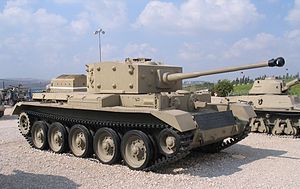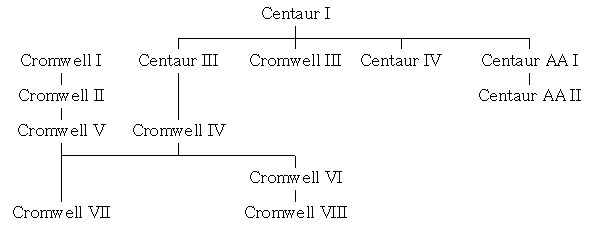Cromwell tank
| Tank, Cruiser, Mk VIII, Cromwell (A27M) | |
|---|---|
 | |
| Type | Cruiser tank |
| Place of origin | United Kingdom |
| Service history | |
| In service | - |
| Used by | British Army |
| Wars | Second World War |
| Production history | |
| Manufacturer | Nuffield Organisation |
| No. built | 4,016 |
| Specifications | |
| Mass | 27.6 long tons (28 tonnes) |
| Length | 20 ft 10 in (6.35 m) |
| Width | 9 ft 6½ in (2.91 m) |
| Height | 9 ft 3½ in(2.83 m) |
| Crew | 5 (Commander, gunner, loader, driver, co-driver) |
| Armour | 3 inch (76 mm) |
Main armament | OQF 75 mm |
Secondary armament | 2 x 7.92 mm Besa MG |
| Engine | Rolls-Royce Meteor V12 petrol 600 hp (447 kW) |
| Power/weight | 21.4 hp/ton |
| Suspension | Improved Christie |
Operational range | 174 miles (280 km) |
| Maximum speed | 40 mph (64 km/h) |
The Tank, Cruiser, Mk VIII, Cromwell (A27M), named after the English Civil War leader Oliver Cromwell[citation needed], was one of the most successful series of cruiser tanks fielded by Britain in World War II. It was the first tank in the British arsenal to combine a dual-purpose gun, high speed, and reasonable armour. Late in the war it was the commonest British design in use, replacing the Sherman tank for some units. Its design formed the basis of the formidable Comet.
History
The Cromwell was the product of further development of British cruiser tanks, and was designed as the replacement for the Crusader tank, which was fast becoming obsolete. In late 1940, the General Staff set out the specifications for the new tank, and designs were submitted in early 1941. It was designed by the Birmingham Railway Carriage and Wagon Company.[1]
Due to the typical rushed production and lack of components, the first of these tanks to be accepted, the Cavalier, had far too many problems to see active combat service. One of the key problems was that its Nuffield-built Liberty engine was simply not up to the task.
A new engine, based on the powerful Merlin engine used in aircraft such as the Spitfire, was designed and called the Meteor. Rolls-Royce, the makers of the Merlin, were already fully committed to its manufacture and could not spare the facilities for the Meteor, and manufacture was passed to the Rover Car Company. A modified tank design, the A27 Mk VIII, was then drawn up to take advantage of the new power available, approximately 600 hp (447 kW), double that of the Liberty.
It would take considerable time for Rover to make ready production lines for the Meteor, so the initial A27s were equipped with the antiquated Liberty engine. These became known as A27L Centaur. It was not until a few months later, in January 1943, that sufficient Meteor engines were available and the A27M Cromwell began production.
Total A27 production consisted of 4,016 gun tanks; 950 of which were Centaurs and 3,066 Cromwells. In addition, 375 Centaur hulls were built to be fitted with an anti-aircraft gun turret; only 95 of these were completed.
The Cromwell still had revisions to make before service, most notably upgunning from the 6-pounder (57 mm) to the ROQF 75 mm gun (an adaptation of the 6 pounder design to fire the ammunition of the US M3 75 mm gun), and it was not until June 1944 that it first saw action during Operation Overlord, the Allied invasion of Normandy. It had a mixed reception by crews. It was faster and had a lower profile than the Sherman tank. However, while its armour was of equivalent thickness, it was less sloped and therefore less effective than that of the Sherman. The 75 mm gun, though able to fire a useful HE shell, was not as effective against armour as the 6 pdr or the 17 pounder that was fitted to the British Firefly variant of the Sherman.
The Centaur was chiefly used for training; only those in specialist roles saw action. The Close Support version of the Centaur[2] saw service as part of the Royal Marine Armoured Support Group on D-Day, and a number were used as the basis for combat engineering vehicles such as an armoured bulldozer
The Sherman remained the most common tank in British and Commonwealth armoured units. Cromwells were used to fully equip only one division, the 7th Armoured Division. The Cromwell was also used as the main tank in the reconnaissance battalions of British armoured divisions because of their great speed. The Cromwell in turn was succeeded by small numbers of the Comet tank. Although the Comet was similar to the Cromwell, and shared some components, it was a much better tank with the 77 mm gun (a version of the 17 pounder)
Post war the Cromwell remained in British Service and was also used by Finland (Charioteer version).
Performance
The Cromwell was the fastest British tank to serve in WW2 [citation needed], with a top (ungoverned) speed of 40 mph or 64 km/h . Unfortunately this speed proved too much for even the Christie suspension and the engine was governed to give a top speed of 32 mph or 51 km/h, which was still fast for its time. Thanks to its Christie parentage the Cromwell was very agile on the battlefield. The dual purpose 75 mm main gun fired the same ammunition as the US 75 mm gun and therefore it had around the same HE and armour-piercing capabilities as the 75 mm equipped Sherman tank. The Cromwell's armour ranged from 8 mm to 76 mm thick overall but the maximum thickness was later increased to 102 mm with appliqué armour plates which were welded on. This armour compared well with that of the Sherman although the Cromwell did not share the Sherman’s sloped glacis plate. The Cromwell crews in North-West Europe succeeded in the Cromwell with superior speed, manoeuvrability and reliability outflanking the heavier and more sluggish German tanks; however, the Cromwell was still not a match for the best German armour and British tank design would go through another stage, the Comet tank, before going ahead in the tank development race with the Centurion tank.
Variants

- Centaur I
- First draft. Armed with the RO QF 6 pounder (57 mm) gun (with 64 rounds of ammunition). It was used only for training. 1059 produced.[citation needed]

- Centaur II
- Mark I with wider tracks and no hull machine gun. Experimental only.
- Centaur III
- Centaur armed with the 75 mm ROQF Mk V gun. In 1943, most Centaur I's were converted to III's, but a few remained as such. 233 produced.[citation needed]
- Centaur IV
- Centaur armed with a 95 mm howitzer (with 51 rounds of ammunition). This is the only version of the Centaur known to have seen combat, in service with the Royal Marines Armoured Support Group. The vehicles were fitted with wading gear to get them ashore. Trunking waterproofed the engine inlets and covers were fitted to the guns. 114 produced.[3]
- Centaur, AA Mk I
- Used a Crusader III, AA Mk II turret with twin 20 mm Polsten AA guns. Were originally deployed in Normandy, but withdrawn as unnecessary due to Allied air superiority. 95 produced.[citation needed]
- Centaur, AA Mk II
- Used a Crusader III, AA Mk III turret with twin 20 mm Polsten AA guns.
- Cromwell I
- Exactly the same as the Centaur I, but using the Meteor engine. Only 357 produced[citation needed] due to the switch from the 6 pounder (57 mm) to the 75 mm gun.

- Cromwell II
- Increased track width and removal of the hull MG to increase stowage. None produced.
- Cromwell III
- Centaur I upgraded with Meteor V12 engine. Only ~ 200 produced[citation needed] due to scarcity of Centaur I's.
- Cromwell IV
- Centaur III upgraded with Meteor engine. The most numerous variant with over 1935 units produced.[citation needed]
- Cromwell IVw
- Meteor engine, and all welded hull.
- Cromwell Vw
- Cromwell built from the start with the 75 mm gun. Used a welded instead of riveted hull.
- Cromwell VI
- Cromwell armed with 95 mm howitzer. 341 produced.[citation needed]
- Cromwell VII
- Cromwell IV and V upgraded with additional armour, wider tracks, and additional gearbox. These were introduced very late in the war and did not see much in the way of combat. ~ 1500 produced.[citation needed]
- Cromwell VIIw
- Cromwell Vw reworked to Cromwell VII standard.
- Cromwell VIII
- Cromwell VI with same upgrades as VII.
-
Centaur IV behind Sword Beach, Normandy, France
Vehicles based on chassis

- Tank, Cruiser, Challenger (A30)
- The design combined lengthened Cromwell chassis and the 17-pounder gun in a new turret.
- SP 17pdr, A30 (Avenger)
- An open turreted version of the Challenger.
- Centaur Dozer
- A Centaur with the turret removed and given a simple dozer blade operated by a winch. One of Hobart's Funnies. 250 produced.
- Centaur OP
- A Centaur with a dummy main gun, and extra radio telecommunications.
- Centaur Kangaroo
- A Centaur with turret removed to make space for passengers. (Few produced)
- Centaur ARV
- A Centaur with turret removed, and replaced with winch fitted instead, and an optional A-frame.
- Cromwell Command/Observation Post
- Cromwell IV, Cromwell VI, or Cromwell VIII fitted with extra radio equipment, and main gun replaced with a dummy gun.
- FV 4101 Charioteer
- Cromwell hull with a 20 pounder in the turret, designed in the 1950s. 200 produced.
Surviving vehicles
- Bovington Tank Museum, Dorset, England. Well preserved Cromwell IV displayed in interior location accessible to public on payment of entry fee to museum.
- Thetford Forest, Norfolk, England. Cromwell IV in outside location freely accessible to public. This tank is located on the A1065 two miles north of Mundford. Between January and May 1944 the area was occupied by armoured regiments of the 7th Armoured Division (Desert Rats) prior to their embarking for Normandy. The tank forms part of a 1998 memorial to the Division. It is in good display condition having been refurbished and painted as a replica of the tank ‘Little Audrey’ of 1st Royal Tank Regiment.[4]
- The RAAC Army Tank Museum, Puckapunyal, Victoria. Cromwell MkI shipped to Australia to assist with the up gunning of the Australian Cruiser tanks but did not arrive before that programme had been terminated. Repainted with the markings it arrived in Australia with, it is now under cover on display at the museum.
- The Israeli Armored Corps Museum in Latrun. Cromwell IV tank, that was used by the IDF in War of Independence (1948 - 1949).
- The Liberty Park in Overloon, The Netherlands. Cromwell IV tank, that remained on the battlefield after Operation Aintree during the Battle for Overloon in October 1944 in which the 11th Armoured Division was involved. This tank is on display in the museum, accessible to the public on payment of entry fee to museum.
Notes and references
- ^ Crawford, Steve. Tanks of World War II, pg. 46
- ^ with a 95 mm howitzer
- ^ Leland Ness, Jane's World War Two Tanks and Fighting Vehicles, p. 22
- ^ "The Desert Rats, 7th Armoured Division, Thetford Forest Memorial".
{{cite web}}: Unknown parameter|accessmonthday=ignored (help); Unknown parameter|accessyear=ignored (|access-date=suggested) (help)
External links
- WWII Vehicles
- OnWar specifications: Cromwell I, Cromwell IV
- LemaireSoft
- Henk of Holland
- Nase noviny
- Photo Gallery of WW2
- Shermanic Firefly



